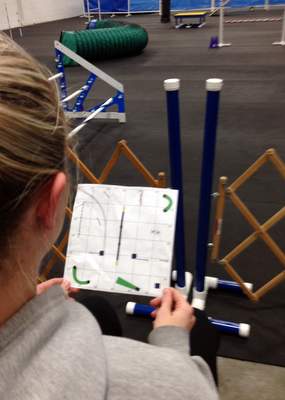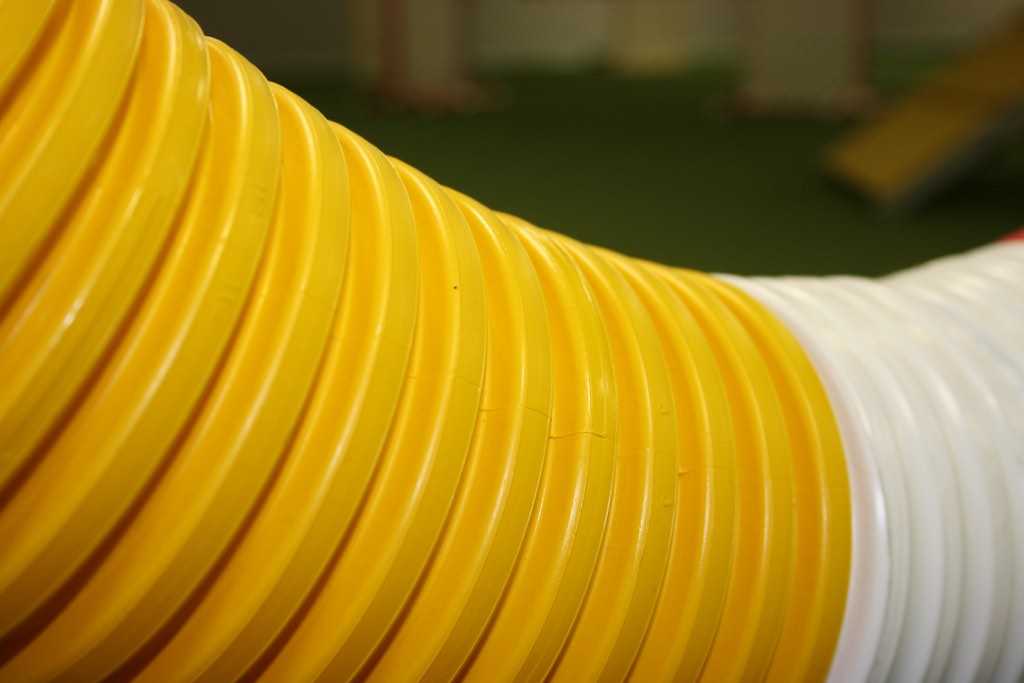Remembering Courses and Conquering Missed Walk Throughs
04 Dec 2013
Just a few weeks ago I arrived at a local USDAA trial thinking we wouldn’t be running for at least an hour and as I walked in to the building I heard the judge say: “Clear the course!” I asked someone if it was Masters Jumpers and they said it was Masters Challenge Jumpers… crud! Flyer and I were entered in that class! I love the “challenge” classes for the more difficult handling puzzles they present.
If that happened to you what would you do? Withdraw or sign in on the gate sheet and go for? I decided I should go for it and I’ll tell you how I got ready for our run.
I hadn’t seen the course map but they let me on the course for literally 1-2 minutes. I found obstacle 1, then 2 and since it was an international style course I couldn’t find obstacle 3. With some coaching from the sidelines I found a couple more obstacles but it soon became clear I wouldn’t figure out the sequence. And then the judge booted me off.
I had 10 dogs ahead of us and two height changes before it was time to run. So less than 10 minutes to get the course in my mind and body, get Flyer, and get to the line.
PAWS
In my article on Handling With Intensity I talked about how preparing to run involves “Really knowing the course and the handling I will use - no doubts, no what-ifs”.

I normally do that through a four step process I’ve started calling PAWS:
- P - Planning my path on a course map.
- A - Adjusting my plan by viewing the course as it is set up - often different from the course map (another reason to help build courses).
- W - Walking and jogging my plan over and over during the walk through to help put the course into my mental and physical/muscle memory (don't underestimate this!).
- S - "Seeing" the obstacles and my handling as I go through the course in my minds eye and physically on the sidelines.
The first three steps are pretty self explanatory. I discuss walking the course in more detail in Handling With Intensity in the section labeled “Preparation”.
A key aspect of this approach to remembering courses and your handling is the forth step: “Seeing”.
Seeing
For me “Seeing” isn’t what most people call “visualization”. I’m not imagining us winning or picturing myself running the course as though I was watching from the sidelines or from above. I’m replaying in my mind what I saw during the walk through and physically going through the motions I will use during the run. I have the mental pictures and physical memory from the walk through to go back to.
I test my memory of my plan by physically moving through my crosses and cues standing at the side of the course/ring. That way I can refer to the course if I can’t remember the next obstacle/cue from memory. I do this with my eyes open and then again with my eyes closed until I can remember it without hesitation.
By cues I really mean all the cues. I’ll physically front cross/rear cross, use my dog’s name or other verbals. I’m practicing/rehearsing what I walked. I’ll even add in cues for myself: “wrap, get his head, make sure he’s on my left” and so forth, because I want to be certain to do that while running the course.
So I do that at the end of the walk through and periodically afterwards to test/remind myself.
The critical action is to go through the “Seeing” step again with motion/cues to make sure the sequence is firmly locked in when we are 3-4 dogs from entering the ring.
It is easy to get distracted between the walk through and running. We do so many things that push our handling and the course out of our minds. Whether it is discussions with friends (real life and electronic), getting/walking our dog, warming up, using the practice jump, finding someone to video tape or checking the running order progress; each of those things put our course plan and handling further from our minds. (At a National event you might even have multiple walk throughs before your first run and then many hours before you step to the line).
That’s why just before going in the ring I go through the “Seeing” step again (motions too). It is my last chance to refresh my memory and by doing it ring side I can look at the course if I can’t remember a part of the sequence. I have found this step makes a huge difference in how successfully I run the course.
Like any new activity you need to practice it before you see the full benefits. If you really give it a try, especially the final “Seeing” step before entering the ring, I think you will experience the benefits.
Missing the Walk
When you miss your walk through you miss the “Walking” part of PAWS and it does impact what you “See” in your mental walk through. But the rehearsing/seeing step helps a lot.
I still go through a “Planning” step with a course map - heck I couldn’t find the obstacle sequence without it. Unless you don’t have a map, then you have to watch handlers run before your run or walk the outside of the ring and find the obstacles.
I still “Adjust” my plan based on the actual layout of the course by comparing it to the map from the side lines.
If possible I “Walk”, but from around the outside of the ring, and look down all the lines of obstacles so I see what my dog and I will see as we go through the course.
Then I work through the “Seeing” step from the side of the ring. I start by using the map to identify the obstacles on the course and the general flow/sequence. My first goal is to see the sequence of the course by just looking at the obstacles without using the map.
For me it also helps to say the obstacle number as I look at each obstacle. I like to do it because then when I get to an obstacle whose number I can see from where I’m standing I can verify that I’m still on the right sequence. That helps some handlers and confuses others - try it and see if it helps you.
Then I start physically moving through the crosses/cues as I look at each obstacle. I start testing myself starting at the beginning of the sequence by closing my eyes and moving through the cues again. If I get “lost” I open my eyes and look at the course to get back in sync. I keep repeating the motions and verbal/physical cues until I can confidently go through the whole course with my eyes closed. To me that is a good sign that I have it “locked in”.
Then when we get in line just prior to running I run through the “Seeing” step one last time.
Success?
So how did PAWS work for Flyer and me on a challenging Masters Challenge course without a walk through? I went through the steps until I could get through the course in my mind and body with my eyes closed. Then I ran and got Flyer from the car along with his tug. We were “on deck” when I brought him in the building, just enough time to go through “Seeing” the course one last time before stepping in the ring…
Well I’d like to say we “smoked” it. The good news was I didn’t get lost, even for a second, and my handling was as I planned it. We only had one fault, I had planned a forward send with a shoulder pull on the take off a jump and Flyer didn’t see my turning cue before committing to the jump. So he took the jump and turned the wrong way and ultimately back jumped the jump. So just faulty execution on my part, can’t blame my mental preparation prior to entering the ring.
In some ways the challenge of running a tough course without having walked it heightened the fun of handling the course! I really had to be fully aware of where I was, where Flyer was and work the line through each obstacle, adjusting slightly as we went. I never felt better “NQ”ing a course!!
I’ve used this technique for regular trial runs for a few years and it works well. I’ve also done what I described when missing a class course walk through on numerous occasions. But this was the first time I used it without a walk through in a trial and I was happy to have it work so well, especially on such a technical course. You can see a video chalk talk of how I handled this course now too.
More Tips
In practice work through PAWS prior to running a course without walking it. I do it periodically when I’m late for my classes. Rather than try to squeeze in a walk through and disrupt the class I work through PAWS while waiting for our turn and then give it a try. The key is taking preparation seriously (you are doing that when you run in practice anyway right?) and giving it your best effort - imagine there won’t be a chance to run it again…
Today Dog Agility Bloggers are writing on the subject of “The Mental Game” and posting dozens of articles, I’ll bet you can learn more about how they prepare and run courses too. Check out their insights.
If you enjoyed this article won't you please:  Thanks!
Thanks!
Related Tags
Related Articles:
- AKC Premier Standard Courses by Tim Pinneri and Arlyn Sigeti - Video
- Nested Masters/Master Challenge/Novice Fun Run Courses
- Flyer's 1st Trial - Julia Lane Intro Courses
- AKC-like JWW/Premier Novice through Masters Practice Courses
- Fun AKC-like JWW Novice/Advanced Practice Courses
- Fun/Challenging Medium Sized Practice Courses
